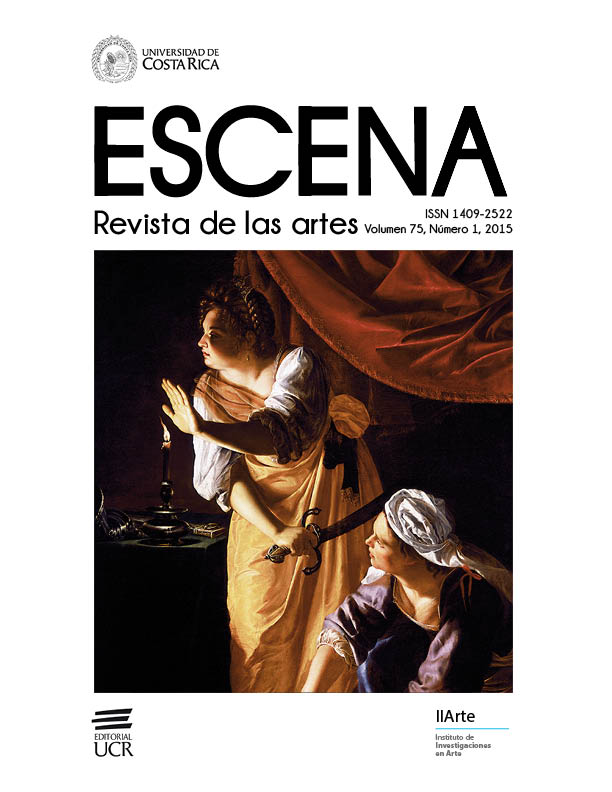Abstract
This paper intends to answer the question of how different artistic languages used by Juan Luis Rodríguez (born in 1934) overlap and how certain issues have persisted in his artistic career, emphasizing the sun as a recurrent theme. It will be used as a case study the mosaic titled Despertar ( Awakening, 2014), which is located opposite the Library Carlos Monge Alfaro at the University of Costa Rica. This artwork is interpreted after reviewing Rodriguez’s career as mosaic artist, after providing an overview of his role as innovator within the history of Costa Rican Art and after studying the survival of the solar motif in his artworks. Regarding the research question, it is determined that the overlap of media and artistic techniques in Rodriguez’s career responds to creative needs, in other words, the artist is not maintained in a continuous renewal process of previous designs, but does this to solve certain artistic problems; for example the Serie solar (Sun Series, 1976-2014). Finally, the analysis of Despertar allows elucidate three meanings around this mosaic: the blazing sun as representation of knowledge, the sunset as a nostalgic reflection and the sun as an invitation to awaken the collective consciousness.References
Alvarado, I. (1995). Juan Luis Rodríguez Sibaja: El combate, retrospectiva. San José, Costa Rica: Fundación de Museos Banco Central de Costa Rica.
_______. (2012). Juan Luis Rodríguez Sibaja: precursor de la contemporaneidad. Revista Comunicación, 21 (1), 78-80.
Bermúdez, M. (2014). Juan Luis Rodríguez Sibaja: sus primeros 80 años. Recuperado el 31 de enero del 2015 de, http://semanariouniversidad.ucr.cr/suplementos/forja/14692-juan-luis-rodriguez-sibaja-sus-primeros-80-anos.html
Bonilla, P. (2013). Algunos pa(i)sajes oscuros en la historia del arte costarricense. Revista Espiga, 12 (25), pp. 121-132.
Carvajal, S. (2014). Juan Luis Rodríguez, su inacabable obra y su incansable memoria. Recuperado el 01 de febrero del 2015 de, http://redcultura.com/php/Articulos1327.htm
Díaz, D. (2003). Mural de Ranucci fue restaurado. Recuperado el 01 de febrero
del 2015 de, http://wvw.nacion.com/viva/2003/junio/20/cul2.html
Echeverría Loría, A. (1972). Con la poesía y la pintura de Francisco Amighetti. En A. Echeverría Loría, De Artes y Letras. Opiniones y Comentarios (pp. 57-61). San José, Costa Rica: Editorial Costa Rica.
Echeverría, C. F. (1977). Ocho artistas costarricenses y una tradición. San José, Costa Rica: Ministerio de Cultura Juventud y Deportes, Departamento de
Publicaciones.
Eco, U. (1992). Los límites de la interpretación (Trad. Helena Lozano). Barcelona: Editorial Lumen.
_____. (1997). Interpretación y sobreinterpretación (Trad. Juan Gabriel López Guix). Cambridge: Cambridge University Press.
_____. (2007). Umberto Eco: Sobre Semiótica y Pragmatismo (Trad. Daniel López Salort). Revista Observaciones Filosóficas, 4. Recuperado de http://www.observacionesfilosoficas.net/umbertoeco.html
_____. (2008). “Perspectivas de una semiótica de las artes visuales” (Trad. Desiderio Navarro). Criterios (25-28), pp. 221-233.
_____. (2009). Semiótica de la cultura. Madrid: Círculo de Bellas Artes.
García Blanco, C. M; Segura Vargas, L. M. (2005). Mural Sede de Limón: Crisol de Culturas. Informe del Proyecto de Graduación para optar por el grado de Licenciatura en Artes Plásticas. Facultad de Bellas Artes, Escuela de Artes Plásticas, Universidad de Costa Rica, San José, Costa Rica.
Goetz, L.J. (2007) A Journey Into the World of Mosaics: Historical and Contemporary Use. Perspective, pp. 42-46.
Guardia Yglesias, M. E. (2004). Las artes plásticas. En: Costa Rica en el siglo XX. Tomo I. San José, Costa Rica: EUNED.
Hall, S. (1997). The work of representation. En S. Hall (Ed.), Representation: cultural representations and signifying practices (pp. 15 – 69). Londres: Sage.
Jaton, F. (2012). Mosaico bizantino/ Smalti en Buenos Aires 2012. Recuperado el 28 de septiembre del 2015 de, http://manosalaobratv.ning.com/group/arteenvidrio/forum/topics/mosaico-bizantino-smalti-en-buenos-aires-2013
Jiménez Deredia, J. (2004). Pensamiento escrito en escultura. Educare, (6), pp. 13-20.
Kolorines. (2015). Kolorines. Recuperado el 21 de septiembre del 2015 de, http://kolorines.com/kolorines_esp.html
Kluber, G. (2003). Arte y arquitectura en la América Precolonial. Los pueblos mexicanos, mayas y andino. Madrid: Cátedra.
Loría, V. (1999). La instalación en Costa Rica. Tesis de graduación presentada para optar al grado de Licenciada en Historia del Arte. Escuela de Artes Plásticas, Universidad de Costa Rica, San José, Costa Rica.
Mosaic Art Source. (2006). Mosaic Glossary. Recuperado el 28 de septiembre del 2015 de, http://www.mosaicartsource.com/mosaicart/mosaic_art_resource/mosaic_glossary.html#m
Mandujano, U. (2011). Entre ficción y mentira. Umberto Eco y la semiótica de la cultura. Saarbrücken: Editorial académica española.
Montero, G. (2012). La I Bienal Centroamericana de Pintura. Káñina. Revista de Artes y Letras, 36 (3), 85-89.
Mora, J. E. (2014). UCR ya tiene un mural de Juan Luis Rodríguez. Semanario Universidad. 22 de octubre. p. 16.
Museo de Arte y Diseño Contemporáneo. (2009). MADC 94/09: Diálogos y Correspondencias. San José: Museo de Arte y Diseño Contemporáneo.
Nobis, N. (1992). Kunst aus Costa Rica: die expressionistischen Tendenzen. Hannover: Sprengel Museum.
O´ Neal Coto, K. (2014). Mural “Despertar” habita en el corazón de la UCR. Recuperado el 03 de febrero del 2015 de, http://www.ucr.ac.cr/noticias/2014/11/05/mural-despertar-habita-en-el-corazon-dela-ucr/imprimir.html
Payró, J. (1970). Introducción a la pintura expresionista. Bogotá: Editorial Columba.
Triana, M. A. (2012). Lola Fernández, alquimista. Recuperado el 01 de febrero
del 2015 de, http://www.nacion.com/archivo/Lola-Fernandez-alquimista_
_1300470011.html
Ulloa Barrenechea, R. (1978). Pintores de Costa Rica. San José, Costa Rica: Editorial Costa Rica.
Universidad de Costa Rica. (2015) (A). Símbolos Universitario. Recuperado el 03 de febrero del 2015 de, http://www.ucr.ac.cr/ acerca-u/historia-simbolos/simbolos.html
Universidad de Costa Rica. (2015) (B). Mapa interactivo campus UCR. Recuperado el 03 de febrero del 2015 de, http://www.ucr.ac.cr/mapas/sede-central.html
Vives Luque, I. (s.f). Arquitectura para una historia: los edificios de la Biblioteca Nacional Miguel Obregón Lizano. Recuperado el 01 de febrero del 2015 de, http://www.sinabi.go.cr/exhibiciones/subportales%20tematicos/historia%20de%20la%20biblioteca%20nacional/fotografias/Arquitectura_
para_una_historia_5.pdf
Wolf, N. (2006). Expresionismo. Colonia: Taschen.
Zavaleta Ochoa, E. (1994). Los orígenes del arte abstracto en Costa Rica 1958-1971. San José, Costa Rica: Museo de Arte Costarricense.


